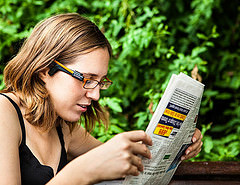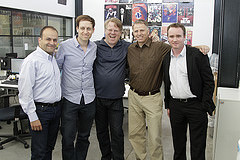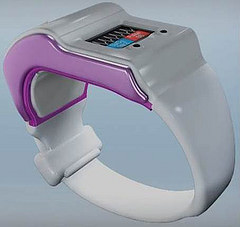Robert Scoble, one of America’s most highly regarded “tech evangelists,” was the featured guest at the inaugural WearableTech Conference in Tel Aviv in May 2014. Participants from several countries came to see how Israeli ingenuity can give them a leg up in this cutting-edge field.
“I think a lot of the wearables will come out of Israel,” Scoble says, noting that sensors, sophisticated algorithms and nanotechnology -- fields in which Israel excels -- are all integral to wearable devices hooked up to the Internet of Things (IoT).
He cites as examples PrimeSense, the Israeli motion-tracking chip technology for the Xbox 360 that was acquired last November by Apple; Omek gesture recognition software, bought by Intel for $40 million; and
OrCam smart glasses for the visually impaired.

Orcam’s smart glasses for the visually impaired.
“Everyone wants to be in this space, and Israel has a big role in it, so that’s why all these people came to the WearableTech Conference,” says Nir Kouris, cofounder of Innovation Israel and one of the organizers of the WearableTech conference.
Aside from the well-known Google Glass wearable computer, many other space-age products are on the horizon, such as the Basis health-tracker watch in which Intel invested heavily, Google’s Android Wear software platform, Apple’s iWatch and Samsung’s Galaxy Gear.
“Intel is investing in a wearables team here,” Scoble said during his presentation at Jerusalem Venture Partners (JVP), an early-stage investment house. He also mentioned that GE does a lot of its imaging R&D in Haifa.
“And Israel has a lot of expertise in inkjet printing, so you might think about a printer that can spray transistors onto anything.”
Julien Blin, managing director of Gizworld.com, a global mobile/wearable computing consultancy in California, echoed Scoble and added that much of this knowhow comes out of the Israel Defense Forces. “Those guys coming out of the military really know how to build algorithms and sensors,” says Blin.
International summit
Kouris says the WearableTech Conference was a smashing success. “It was really an international summit, and a lot of deals are coming out of this,” he says. Many participants came from Asian countries, including 28 people from China.
 From left, JVP Partner Yoav Tzruya, Nir Kouris, Robert Scoble, JVP Partner Uri Adoni and wearable computing/IoT strategist Julien Blin. Photo by Kobi Natan
From left, JVP Partner Yoav Tzruya, Nir Kouris, Robert Scoble, JVP Partner Uri Adoni and wearable computing/IoT strategist Julien Blin. Photo by Kobi Natan
Among the Israeli startups that presented at the main event in Tel Aviv were
MUV Interactive, which makes a glove-like device to turn any surface into a touchscreen; the
Neura predictive and adaptive ecosystem for wearable devices; and the hereO children’s wristwatch, which incorporates the world’s smallest real-time connected GPS tracking device.
Year of the wearables
Kouris, 31, says 2013 was “the year of the wearables,” with many exciting technologies breaking out on the horizon. Some of the most prominent disrupters in this area were at the WearableTech Conference, including the acknowledged “father of wearable technology” Prof. Steve Mann from the University of Toronto. He gave a keynote address wearing the SpaceGlasses mediated reality headset from his company, Meta.

“Father of wearable tech” Prof. Steve Mann demonstrates SpaceGlasses in Tel Aviv.
The day before the main event, a hackathon was led by Jonathan Schipper of Johnny505 Studios in Israel, which does consulting and development for Android, Glass, wearables and the web. Schipper aims to create the first incubator for wearable apps and devices in collaboration with London’s Nonlinear Labs. Mann and Scoble also met with Israeli students to talk about the future of wearable technology.
Scoble says we can expect to be wearing sensor-embedded shirts that transmit heart-rate data to our physicians, ski goggles that tell us where we are on the mountain and how fast we’re going; bracelets with embedded RFID tags so we’ll never have to carry around credit cards. Dogs will wear collars that let owners keep track of how much they’re eating and where they are, and infants will wear onesies embedded with sensors to monitor their breathing.
Some of these futuristic products are almost on the market.
Israel’s
Oxitone, for example, aims to be the world's first medical-grade personalized wrist monitor providing automatic, continuous wireless monitoring of blood oxygen, pulse rate, activity, sleep and breathing patterns. It got a head start as part of GE Healthcare’s Start-Up Health Academy Entrepreneurship Program in 2013.

An Oxitone prototype
“Wearables nowadays are mainly watches or glasses, and glasses are focused on the outside -- what the person sees,” says Tuvia Elbaum, cofounder of Jerusalem-based
Umoove software for face and eye tracking on mobile devices.
“The next step will be looking at what the user’s eyes are doing, and combining the two things. That’s where we come in with our eye-tracking technology. We can add more natural interaction with the glasses.”
Umoove business development manager Jack Gottesman adds, “By tracking the eyes you get an inside look at what the person is thinking. The eyes move involuntarily, as opposed to the face and the hands that are much more controlled. Your eyes are constantly moving around, scanning your environment and the screen and your digital environment also, so by tracking the eyes it’s like looking into the person himself.”